Introduction to Integration
Integration is a way of adding slices to find the whole.
Integration can be used to find areas, volumes, central points and
many useful things. But it is easiest to start with finding the area under the curve of a function like this: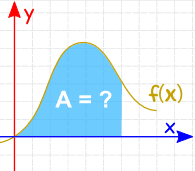
What is the area under y = f(x) ?
Slices
| We could calculate the function at a few points and add up slices of width Δx like this (but the answer won't be very accurate): | 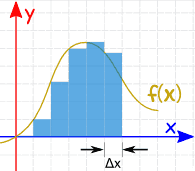 |
|
| We can make Δx a lot smaller and add up many small slices (answer is getting better): | 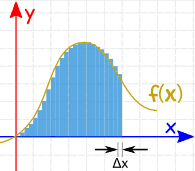 |
|
| And as the slices approach zero in width, the answer approaches the true answer. We now write dx to mean the Δx slices are approaching zero in width. |
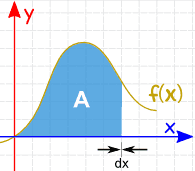 |
this video
click
But we don't have to add them up, as there is a "shortcut". Because ...
... finding an Integral is the reverse of finding a Derivative.
(So you should really know about Derivatives before reading more!)
Like here:Example: What is an integral of 2x?
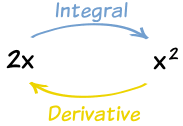
We know that the derivative of x2 is 2x ...
... so an integral of 2x is x2
Notation
| The symbol for "Integral" is a stylish "S" (for "Sum", the idea of summing slices): |
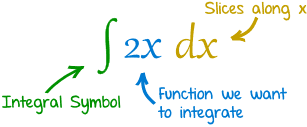 |
and then finish with dx to mean the slices go in the x direction (and approach zero in width).
And here is how we write the answer:

Plus C
We wrote the answer as x2 but why + C ?It is the "Constant of Integration". It is there because of all the functions whose derivative is 2x:
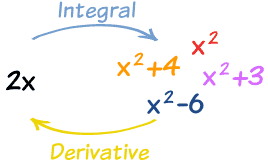
So when we reverse the operation (to find the integral) we only know 2x, but there could have been a constant of any value.
So we wrap up the idea by just writing + C at the end.
Tap and Tank
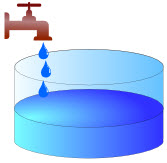
The input (before integration) is the flow rate from the tap.
Integrating the flow (adding up all the little bits of water) gives us the volume of water in the tank.
Imagine the flow starts at 0 and gradually increases (maybe a motor is slowly opening the tap).
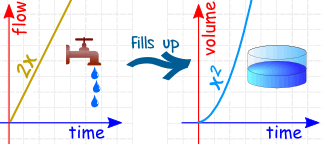
With a flow rate of 2x, the tank fills up at x2.
We have integrated the flow to get the volume.
Example: (assuming the flow is in liters per minute) after 3 minutes (x=3):
- the flow rate has reached 2x = 2×3 = 6 liters/min,
- and the volume has reached x2 = 32 = 9 liters.
We can do the reverse, too:
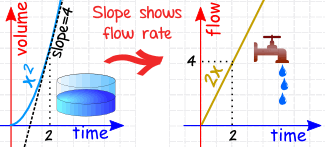
You only know the volume is increasing by x2.
We can go in reverse (using the derivative, which gives us the slope) and find that the flow rate is 2x.
Example: at 2 minutes the slope of the volume is 4, meaning it is
increasing at 4 liters/minute, which is the flow rate. Likewise at 3
minutes the slope is 6, etc.
 |
So Integral and Derivative are opposites. |
| The integral of the flow rate 2x tells us the volume of water: | ∫2x dx = x2 + C | |
| And the slope of the volume increase x2+C gives us back the flow rate: |
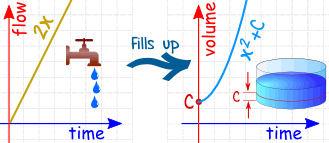
- The flow still increases the volume by the same amount
- And the increase in volume can give us back the flow rate.
Other functions
Well, we have played with y=2x enough now, so how do we integrate other functions?If we are lucky enough to find the function on the result side of a derivative, then (knowing that derivatives and integrals are opposites) we have an answer. But remember to add C.
Example: what is ∫cos(x) dx ?
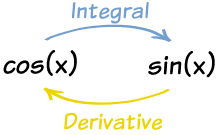
∫cos(x) dx = sin(x) + C
Example: What is ∫x3 dx ?
On Rules of Integration there is a "Power Rule" that says:
∫xn dx = xn+1/(n+1) + C
We can use that rule with n=3:
∫x3 dx = x4 /4 + C
Knowing how to use those rules is the key to being good at Integration.
So get to know those rules and get lots of practice.
Learn the Rules of Integration and Practice! Practice! Practice!
(there are some questions below)
(there are some questions below)
Definite vs Indefinite Integrals
We have been doing Indefinite Integrals so far.A Definite Integral has actual values to calculate between (they are put at the bottom and top of the "S"):
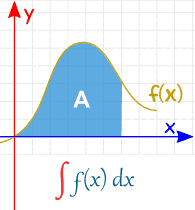 |
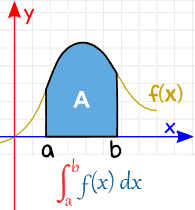 |
|
| Indefinite Integral | Definite Integral |





EmoticonEmoticon